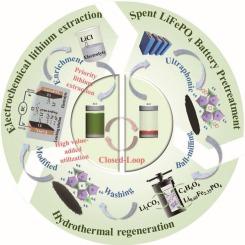Direct hydrothermal regeneration and high value-added utilization of spent lithium iron phosphate for priority lithium extraction from acidic leachate
IF 7.1
2区 环境科学与生态学
Q1 ENGINEERING, ENVIRONMENTAL
引用次数: 0
Abstract
To address the global lithium shortage, direct regeneration of degraded cathodes via lattice reconstruction offers an eco-efficient strategy for recycling spent lithium-ion batteries (LIBs). However, industrial adoption is hindered by residual defects and insufficient lithium replenishment. Here, we propose a groundbreaking high-value reuse pathway, repurposing regenerated lithium iron phosphate (LFP) as an acid-stable adsorbent for priority lithium extraction from acidic leachate. Thermodynamic and electrochemical analyses suggested the stronger reductant facilitate the lattice reconstruction. The regenerated LFP, processed via a 2-hour hydrothermal repair at 220 °C using ascorbic acid, exhibited an exceptional lithium extraction capacity of 38.5 mg/g without electrode dissolution, selectively reducing residual lithium to < 20 ppm. By simultaneously enabling high-value utilization of spent LFP and priority lithium extraction, this paradigm bridges economic viability with circular economy principles, offering a blueprint for upcycling spent LIB materials.

酸性渗滤液中磷酸铁锂直接水热再生及高附加值利用
为了解决全球锂短缺问题,通过晶格重建直接再生降解阴极为回收废旧锂离子电池(lib)提供了一种生态高效的策略。然而,工业采用受到残留缺陷和锂补充不足的阻碍。在这里,我们提出了一种开创性的高价值再利用途径,将再生磷酸铁锂(LFP)作为酸稳定吸附剂,优先从酸性渗滤液中提取锂。热力学和电化学分析表明,强还原剂有利于晶格重构。再生的LFP在220°C下使用抗坏血酸进行2小时的水热修复,在没有电极溶解的情况下,表现出38.5 mg/g的锂提取能力,选择性地将剩余锂还原为
本文章由计算机程序翻译,如有差异,请以英文原文为准。
求助全文
约1分钟内获得全文
求助全文
来源期刊

Waste management
环境科学-工程:环境
CiteScore
15.60
自引率
6.20%
发文量
492
审稿时长
39 days
期刊介绍:
Waste Management is devoted to the presentation and discussion of information on solid wastes,it covers the entire lifecycle of solid. wastes.
Scope:
Addresses solid wastes in both industrialized and economically developing countries
Covers various types of solid wastes, including:
Municipal (e.g., residential, institutional, commercial, light industrial)
Agricultural
Special (e.g., C and D, healthcare, household hazardous wastes, sewage sludge)
 求助内容:
求助内容: 应助结果提醒方式:
应助结果提醒方式:


